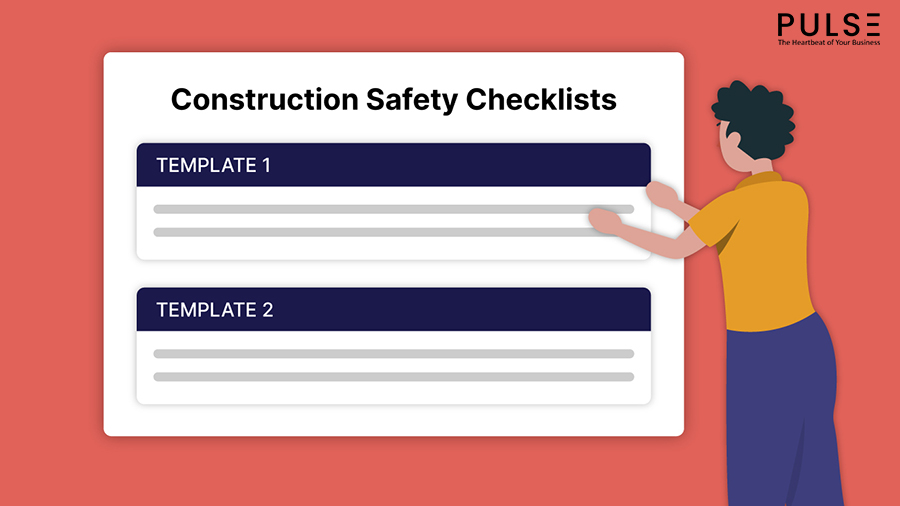The construction industry involves massive projects, tens to hundreds and thousands of people working on them, and extremely high stakes. According to a 2018 OSHA survey, 21.1% of private-sector work-related deaths happened in the construction industry. So it goes without saying, the pertinence to ensure safety here is of utmost priority.
Hence, safety inspection checklists are paper or digital forms that safety officials use to inspect and identify workplace dangers that could affect people, processes, or the environment.
Multiple checklists are custom-made for the construction sector — pre-work checklists, quality control checklists, project planning checklists, etc. But considering the nature of work involved in the construction business and the high risks, the ‘Construction Safety Checklist’ holds extreme importance.
Having a comprehensive and holistically designed construction safety checklist can help mitigate the health and safety risks inherent to the construction industry by a considerable degree.
But what makes a perfect checklist? The answer lies in a digitized system that has these six tips inculcated in it.
6 Pro-Tips for Creating Efficient and Effective Construction Safety Checklists

A construction site should draft a checklist with proper planning, strategy, and diligence, keeping in mind the result it aims to achieve. Therefore, an ideal checklist should be:
1. Appropriately Customized
Each construction site is different, and each project is unique. Hence, your safety checklist should consider the specificities of that particular project where it is supposed to be put to use.
For instance, a project that involves underground drilling and digging has to include the checkpoints for drainage and earthworks safety specifically. In contrast, one working at heights should consider safety inspection for fall protection in the listing.
2. Thorough
In construction safety checklists, all the safety and health risks involved must be considered, including causes of the said risks and measures to mitigate them.
For instance, consider the following:
- Does the checklist have a plan?
- Are the safety gears included?
- Was the safety meeting conducted?
- Are the blind spots covered?
- Are separate working wings ready?
The list will go on as per your requirement and based on the thorough study of your site.
Only then should the checklist be drawn up. This will confirm that it is comprehensive and covers all the necessary red flags. Hence, a thorough checklist is always a must.
3. User-friendly
Checklists should be the right mix of customization and standardization. For example, several pre-built industry-standard templates can be the starting point of any construction safety checklist.
They should not be too complicated or arbitrary such that it confuses those filling them up. With standardized user-friendly checklist formats, the workers and contractors get accustomed to and comfortable completing the construction safety checklists, increasing their effectiveness.
Whether it is keeping a consistent format with checkboxes, text-boxes, or providing guiding notes alongside questions to help answer the questions better – the more user-friendly the checklist, the better results it would yield.
4. Up-to-Date
Many construction companies already have pre-defined safety checklists. However, they fail to keep them up-to-date, and that often leads to severe lapses.
Safety compliance in the construction sector is undergoing revolutionary changes in automation, digitization, robotics, etc. As a result, PPE kits are modified, processes are changing, and safety gear is revamped. Therefore, the construction safety checklists have to be amended time and again to reflect these changes and consider the new risks, if any, on account of these changes.
If you continue to use age-old checklists, they would no longer be relevant; and chances are many safety compliances may go unnoticed. Hence, a periodic review of all the checklists is necessary to ensure they are updated and pertinent.
5. Auditable
Health and safety compliance in the construction industry is a very critical subject. Lives are at stake. No surprises, therefore, that these compliances are put under the scanner time and again in the form of proactive internal audits, safety inspections, or compliance audits. They may also have to face stringent OSHA Audits, which is why construction safety checklists should always be designed to be easily auditable.
This means the checklists should be clear, concise, and unambiguous. In addition, they should have enough details to answer all the auditors’ questions and stand as a piece of reliable evidence of documentation.
6. Digital
This is perhaps one of the most critical points in today’s times. With the world going digital, checklists are not far behind. A safety checklist in a digital format ensures freedom from files and folders full of paper checklists, which themselves can pose a fire hazard!
Digital checklists are easily editable, stored easily, and integrated with different applications across the organization. Keeping the construction safety checklist digital makes it more convenient and time-saving for the team to complete it, not to mention the reduced risk of losing paper checklists.
Digital safety checklists help make internal audits seamless. It’s as easy as ticking the boxes, uploading site photos, and delegating tasks with a few clicks.
Nail Construction Safety Checklists with Pulse
At Pulse, we have a number of checklists under the umbrella of construction safety checklists. These checklists are digitized, backed by Artificial Intelligence, and customized to specific requirements.
You can choose from any of our time-tested ready checklist templates, or build your very own customized ones, or even convert your existing paper checklists into state-of-the-art digital templates.
Just as craftsmen swear by their tools and vouch for them with all sincerity, we at Pulse are passionately aware of the difference our checklists can make to your business. Rather than take our word for it, sign up for a 30-day free trial for Pulse Pro and experience firsthand how perfectly designed checklists can transform your business.
